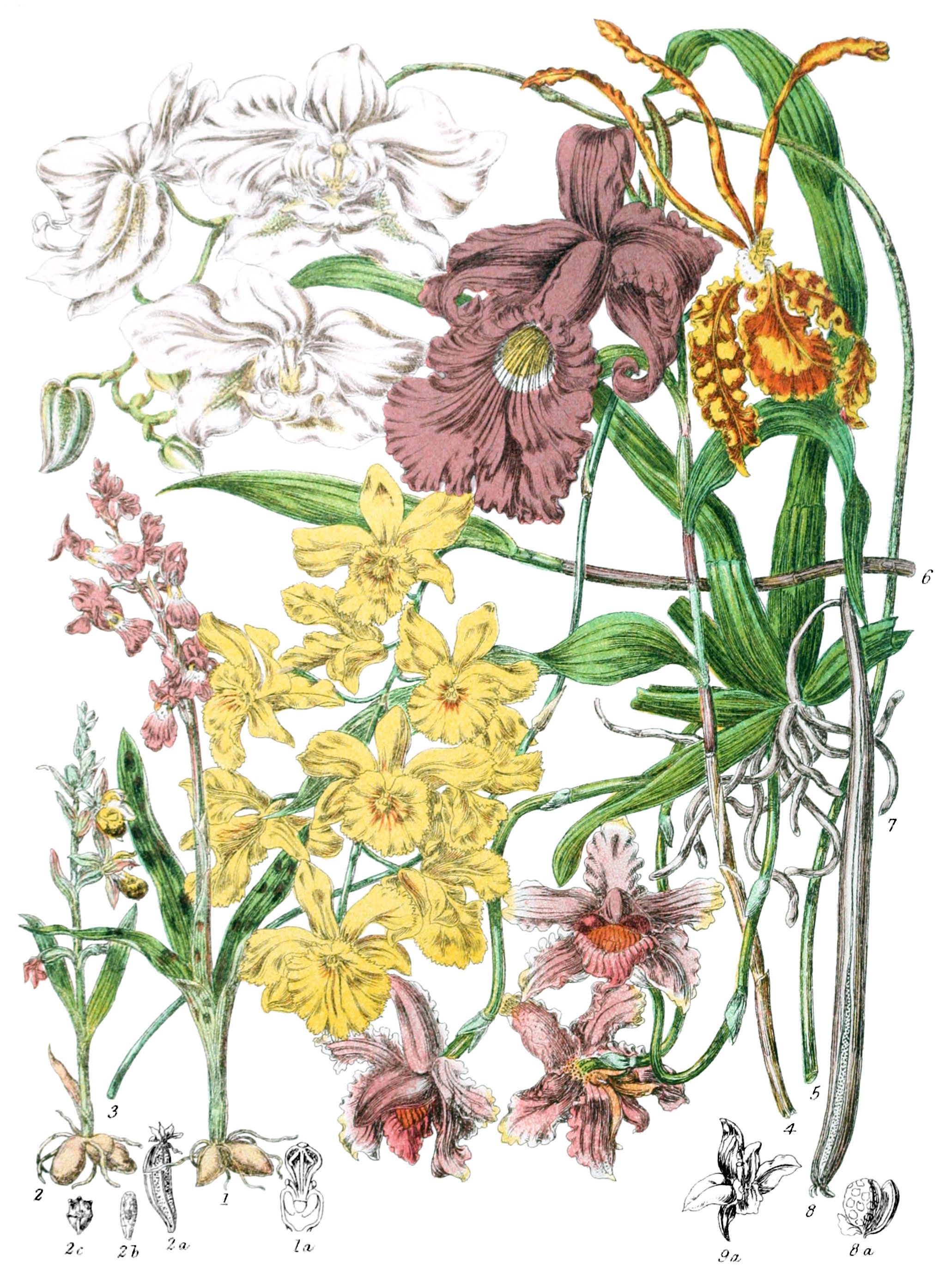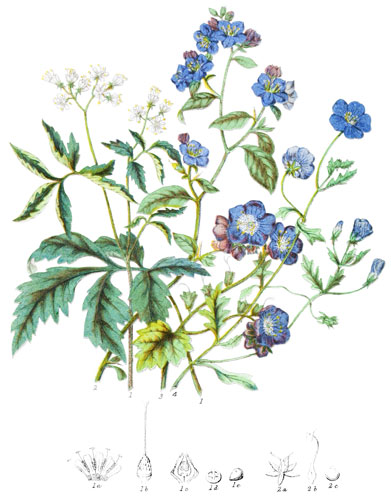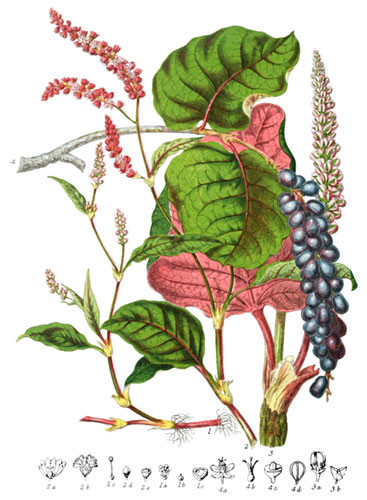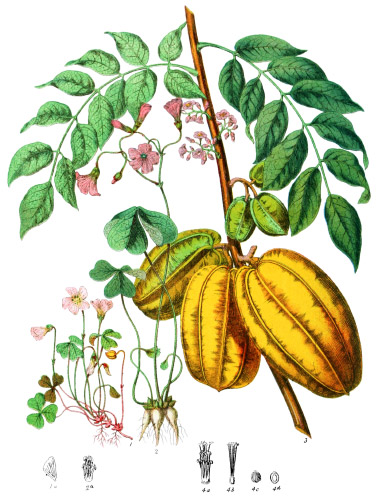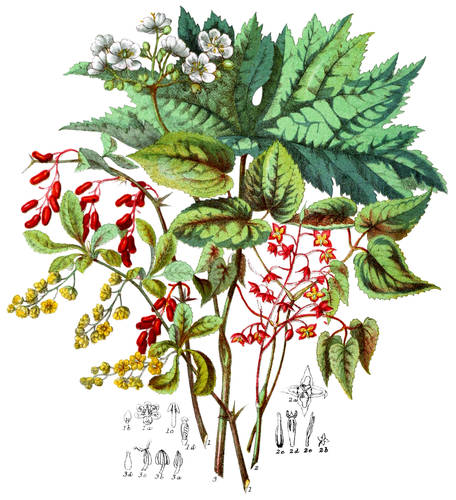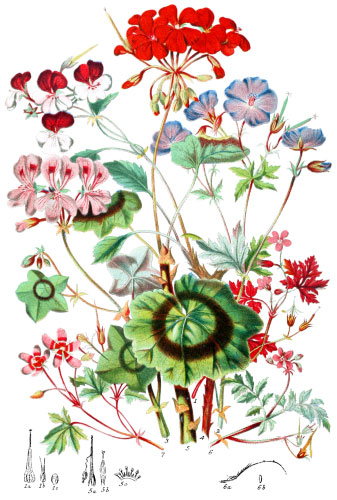Key characteristics
Shrubs and herbaceous plants, all perennial; terrestrial, or aerial fixed on trees and stones. The roots are fibrous or fleshy, like tubers full of starch. The stem is either long and annual, or woody and perennial, forming jointed branches. The leaves are flat or round, sometimes growing one over the other like Iris; generally sheathing, membranous, coriaceous or hard, never lobed, occasionally bordered by cartilaginous teeth, veins parallel. The flowers are irregular in form, solitary, clustered, spikes, or panicled; a single bract at their base. The corolla is adherent, herbaceous or coloured, membranous or fleshy, the sepals are three, petals three, one developed into a lip of very differing form, horned, or furnished with various appendages, occasionally moving spontaneously as in Bolbophyllum. The stamens and style are consolidated into a column; the three stamens the central one only is perfect, except in Cypripedium, where the two side anthers are perfect, the central one imperfect. The anthers are erect at the top of the column, or turned flat upon it, the pollen powdery or waxy. The ovary is formed of six carpels, three of which bear stigmas, and three have double plates bearing numerous minute seeds. The style is rarely distinct except in Cypripedium. The capsule, seldom fleshy, usually separating into six dry, woody rigid valves; seeds, with a loose netted skin, rarely a hard crustaceous covering, and sometimes expanded into a circular wing. They contain no albumen.
This Tribe has affinity with Zingiberaceæ and Iridaceæ.
The starchy roots of some, and the aromatic capsules of Vanilla are the chief useful parts.
Select plants in this order
Not all plants listed are illustrated and not all plants illustrated are listed.
- Orchis, the old Greek name, denotes a remarkable genus which has been taken as the type of an extensive natural Order of exceedingly interesting plants, of late years chiefly discovered and brought forth out of uninhabited forests to display their varied forms of marvellous beauty to the gaze of man. Several exhibit a tendency to the shape and colours of insects, as is clearly perceptible in many English species: Ophrys apifera (2), O. aranifera and others. But it is the heat and moisture of Tropical woods that the most curious examples are to be found, especially those which are capable of growth without earth, deriving nourishment solely from the air.
- Orchis mascula (1) is frequent in groves and shaded meadows; the roots contain a supply of wholesome starchy substance, made into a nourishing food called salep, after an Arabic name.
- O. foliosa of Madeira resembles our O. latifolia, but is much taller, the leafy spike being a foot long.
- O. canariensis, in the valley of Orotava in Teneriffe, is the most southern example of the genus.
- One of the most rare of British Orchids is the Cypripedium calceolus, the Ladies’ Slipper, now only occasionally found in its former localities of Arncliffe, and Igleborough in Yorkshire. This genus is remarkable as having on the column two perfect side anthers, instead of one terminal as in other genera. The lip is expanded into a hollow pouch, and all the peculiarities of the genus are shown as clearly as in C. insigne of Nepal, or in the North American species.
- Epipactis grandiflora is a beautiful English species, the cream-coloured flowers (9)* growing on a tall spike.
- In the primæval forests of Brazil Oncidium abounds, the flowers generally produced on very long stalks, usually of a pale yellow, marked with brown.
- O. papilio (3) has a striking resemblance to a butterfly resting on the slender stalk.
- Sobralia is a stately genus, rising with a reed-like stem bearing stiff plaited leaves, and noble fragrant flowers.
- Phalænopsis (5), with its fair flowers having the aspect of a moth, is an extremely elegant plant.
- Of East Indian Orchids Dendrobium is one of the finest; D. fibriantum (6) of pure tint; other species marked with dark brown; D. cærulescens, at 4000 feet on the mountains of Khosea, bears forty flowers on its stem.
- Among the countless plants which struggle for space on the small islands of the Berbice and Essequibo, Huntleya violacea (7) was discovered by Sir Robert Schomburgk, covering gigantic trees in the humid air from the spray of cataracts, where the sun scarcely penetrates.
- Cattleya superba of Guiana is unsurpassed for beauty, fragrance, and duration; Schomburgkia crispa is also a graceful species of that country; S. marginata belongs to Surinam.
- Galeandra grows six feet high, in large clusters, on the Mauritia palm.
- Of the East Indian plants of this tribe Cymbidium, Cœlogyne, Ærides, Camarotis, and Phaius are amongst the most remarkable in variety of form and hue, and manner of growth.
- Cynoches of Mexico and Demerara has a long bent column with a dark knob at the end.
- Epidendrum vitellinum unfolds its spikes of brilliant scarlet flowers in a temperate climate at 9000 feet elevation on the mountains of Mexico.
- On the margins of pools at the base of the Table Mountain of the Cape, Disa grandiflora opens its crimson flowers, when the hot mists succeed to the frosts and drought.
- The long seed-vessels of Vanilla (8) are used to flavour chocolate.
Locations
This Tribe is dispersed almost in all countries, except in the coldest regions, or the dry parts of Africa. In the hot damp regions of the East and West Indies and South America the species with aerial roots abound. Many belong to Central America and the Cape of Good Hope, as well as to Australia and Europe.
Legend
- Orchis mascula, Early Purple Orchis. Woods, England.
- Column with Pistil and Anthers.
- Ophrys apifera, Bee Orchis. England.
- Seed-vessel.
- Seed, magnified.
- Section of Seed-vessel.
- Oncdium Papilio. Trinidad.
- Sobralia macrantha. Guatemala.
- Phalænopsis amabile. Manilla.
- Dendrobium fibriatum. East Indies.
- Huntleya violacea. Guiana.
- Vanilla planifolium.
- Seed magnified 200.
-
- Epipactis grandiflora. Flower.
*9 was mentioned in the original description but only 9a was illustrated.
Explore more
Posters
Decorate your walls with colorful detailed posters based on Elizabeth Twining’s beautiful two-volume set from 1868.
Puzzles
Challenge yourself or someone else to assemble a puzzle of all 160 botanical illustrations.
